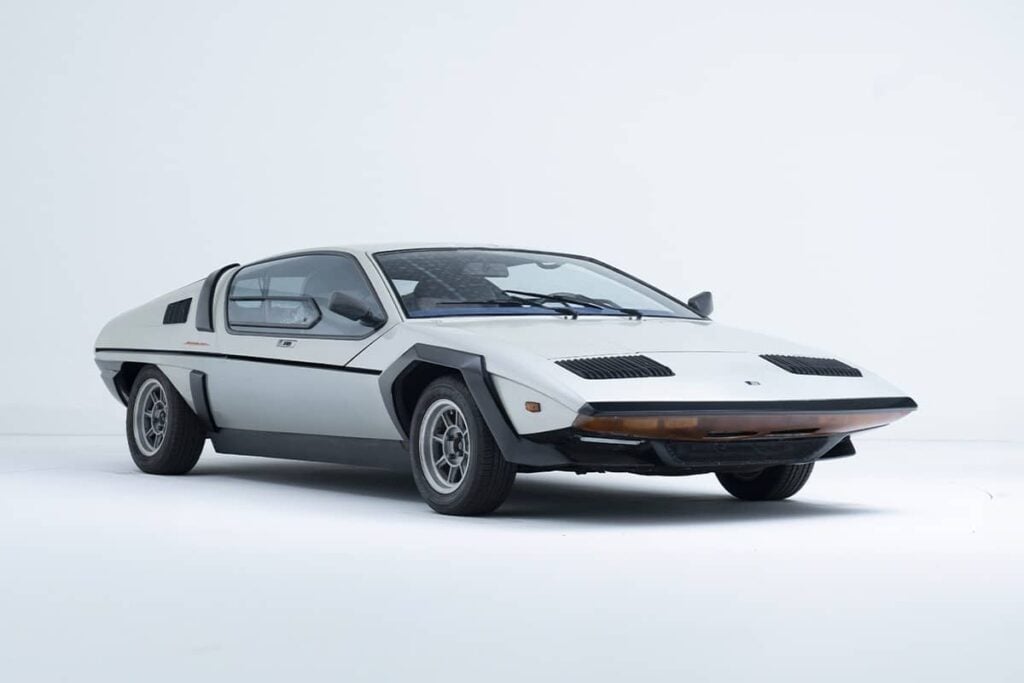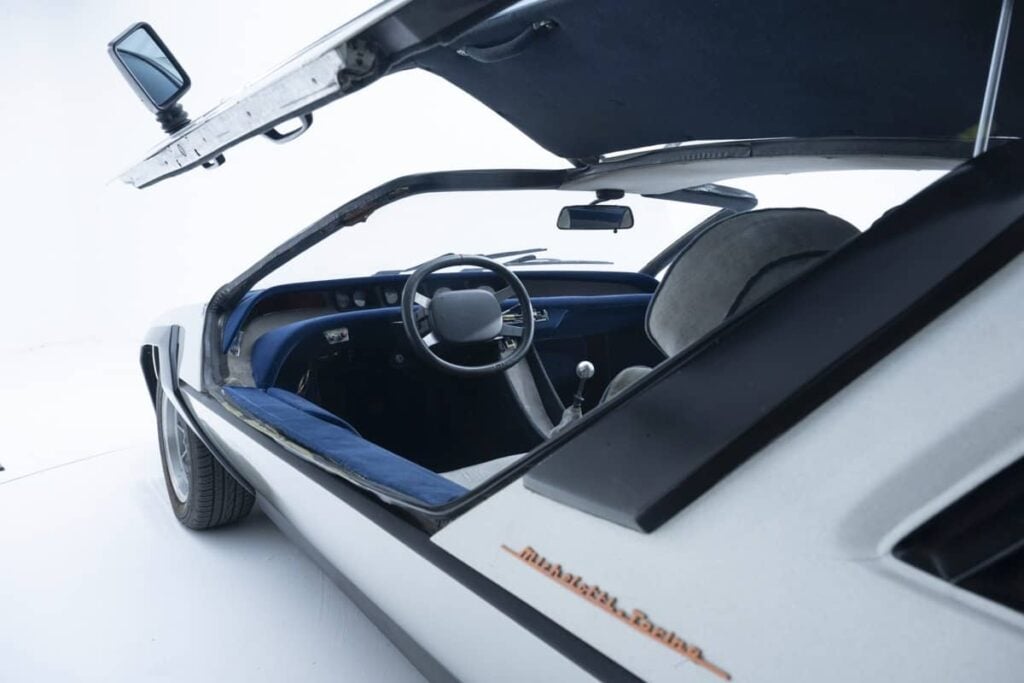1971 Matra LASER Concept Car

The 1971 Matra LASER stands as one of the most striking yet overlooked concept cars of the wedge era. Designed and built by legendary Italian stylist Giovanni Michelotti, this one-off prototype represented a bold fusion of French engineering, Italian design flair, and unconventional Ford power – a combination that would captivate audiences at motor shows while simultaneously foreshadowing the dramatic automotive styling trends of the 1970s.
A Radical Design

The LASER’s story begins with the French aerospace and automotive company Matra, which had already established itself as a formidable force in motorsport by 1971. The company had won the Formula One Constructors’ Championship in 1969 with Jackie Stewart at the wheel, and was building toward its eventual domination of endurance racing with three consecutive Le Mans victories from 1972 to 1974. This racing pedigree provided the perfect backdrop for an audacious design study.
Michelotti chose to build his concept on the chassis of the Matra M530, the company’s first true in-house sports car that had entered production in 1967. Named after Matra’s R.530 surface-to-air missile, the M530 featured a mid-mounted 1.7L Ford Taunus V4 engine producing between 73 and 78 horsepower, mated to a four-speed manual transmission. The car’s platform chassis, constructed from perforated sheet steel for lightness and topped with fiberglass bodywork, provided an ideal foundation for Michelotti’s radical reimagining.
The Mind Behind the LASER: Giovanni Michelotti
By 1971, Giovanni Michelotti had already established himself as one of the most productive and versatile automotive designers of the postwar era, though his contributions often went unrecognized. Born in Turin in 1921, Michelotti began his career at age 15 as an apprentice at Stabilimenti Farina, working under the brother of legendary designer Battista “Pinin” Farina. After honing his skills at various coachbuilders including Vignale, he opened his own design studio in 1949, becoming Italy’s first independent automotive design consultant.
Michelotti’s styling touched an impressive array of projects, ranging from Ferraris and Maseratis to microcars. His philosophy was simple yet profound: “a camel is made into a horse by the designer”. At the 1954 Turin Motor Show alone, more than thirty vehicles bearing his designs were displayed across different stands, though he was contractually forbidden from claiming credit for most of them. His work with British manufacturer Triumph proved particularly significant, as he designed all Triumph models for a decade, including the iconic TR4 and Spitfire.
Origin of the Matra LASER
For the LASER project, Michelotti’s team was led by Japanese designer Tateo Uchida, who served as chief designer under Michelotti’s guidance. The collaboration resulted in a design that epitomized the wedge-shaped aesthetic that dominated concept car thinking in the early 1970s. This angular, low-slung styling philosophy, championed by designers like Marcello Gandini with his 1968 Alfa Romeo Carabo, represented a radical departure from the curved, organic forms that had defined automotive design in previous decades.
The LASER’s silhouette was dramatic and uncompromising. At just 1,080 millimeters tall – barely over three and a half feet – the car sat incredibly low to the ground. This extreme stance was both a design statement and a practical consideration, as the wedge profile demanded minimal height to achieve its knife-like appearance. The car’s most distinctive feature was its gullwing doors, which opened upward to provide access to the interior. This design element, shared with many of Michelotti’s experimental cars from the same period, added theatrical flair while solving the practical challenge of entry and exit in such a low vehicle.

The LASER featured exceptionally wide side sills that served multiple purposes. These chunky door sills weren’t merely decorative – they were engineered to increase structural rigidity of the fiberglass body while simultaneously channeling cooling air to the Ford V4 engine positioned behind the passenger compartment. This pragmatic approach to design exemplified Michelotti’s philosophy of combining form with function, ensuring that even the most visually striking elements served a mechanical purpose.
Public Debut
The LASER made its world debut at the 1971 Geneva Motor Show, finished in a striking shade of yellow that ensured it commanded attention among the sea of concept cars. The prototype’s dramatic appearance and futuristic design language captured the imagination of show attendees, representing the optimistic, technology-focused aesthetic that characterized early 1970s automotive design.
Following its Geneva debut, the LASER underwent subtle styling modifications before being displayed at the 1972 Montreal Auto Salon. For this second appearance, the car was repainted in a more subdued silver finish, trading the attention-grabbing yellow for a color scheme that emphasized the purity of its angular lines. These minor design changes refined the concept without fundamentally altering its character, demonstrating Michelotti’s willingness to evolve his designs based on feedback and reflection.
Disappearing Matra LASER

True to its status as a one-off prototype, the LASER was never intended for production. Following its motor show appearances, the car was inducted into a private automotive museum collection where it would remain for years. Then, in 1999, the LASER seemingly vanished from the automotive world entirely. Its disappearance was so complete that even Edgardo Michelotti, Giovanni’s son who had taken over the family business, spent ten years searching in vain for the car, considering it an integral part of his father’s legacy.
The mystery of the LASER’s whereabouts persisted for a decade until 2009, when the car miraculously resurfaced at the 2nd Tokyo Concours d’Elegance in Japan. Its reappearance was a revelation to automotive historians and design enthusiasts who had assumed the car might be lost forever. At the Tokyo event, the LASER took its place among illustrious company, sharing the spotlight with a Ferrari 250 GTE 2+2, a Lamborghini 400GT 2+2, and a pristine Maserati Mistral Spyder – a testament to how highly regarded this humble concept built on production Matra mechanicals had become over the decades.
The LASER remained in Japan and was offered for sale in 2023 with an asking price around $280,000. This past weekend, on November 9, 2025 the LASER was sold at a BH Auction at City Circuit Tokyo Bay for ¥25,308,000, around $165,000.
Matra LASER's Place in History

Today, the Matra LASER occupies a fascinating position in automotive history. It remains largely unknown outside circles of concept car enthusiasts and Italian design aficionados, overshadowed by more famous wedge-era contemporaries like the Lamborghini Countach, Lotus Esprit, and Ferrari 512S Berlinetta Speciale. Yet for those familiar with its story, the LASER represents something special: a pure expression of early 1970s optimism and design ambition, created by one of the era’s most talented yet underappreciated stylists.
The car’s dramatic rescue from obscurity – first disappearing in 1999, then dramatically reappearing in Japan a decade later – has only added to its mystique. That it now commands significant collector interest speaks to growing appreciation for concept cars as historical artifacts worthy of preservation and study.
It also serves as a reminder of the brief but brilliant time of Matra as a true automotive powerhouse. Mostly remembered for its motorsport success – especially its Formula One Championship and victories at Le Mans – Matra also produced road-going cars like the M530, Bagheera, and Murena that brought mid-engine performance to a wider audience. Though the LASER was never produced, it represents the pinnacle of Matra’s ambitions at that time.
In the context of wedge design, the LASER stands as evidence of how thoroughly this aesthetic movement permeated automotive design in the early 1970s. From major manufacturers to small specialists, from production cars to pure concept studies, the wedge shape seemed to represent the inevitable future of automotive styling. That this future never fully materialized – with more organic, aerodynamically refined shapes eventually reasserting dominance – makes cars like the LASER valuable time capsules of a moment when sharp angles and flat planes seemed poised to define automotive design for generations to come.
The 1971 Matra LASER by Michelotti remains a testament to an era of bold experimentation, to a designer whose talent exceeded his fame, and to a French company that dared to compete against Italian design houses on their own terms. Nearly 55 years after its Geneva debut, this yellow-then-silver wedge continues to captivate those fortunate enough to encounter it, a razor-sharp reminder of roads not taken and futures once imagined.
